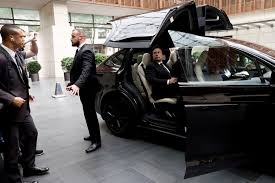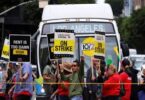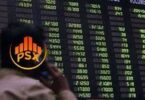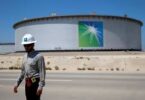WASHINGTON (Reuters): Elon Musk has kept investors hanging since he issued cryptic social posts following an exclusive April 5 Reuters report that Tesla had scrapped its plans for a $25,000 “Model 2” electric vehicle.
“Reuters is lying,” Musk wrote in one post that day, without identifying any inaccuracies.
Nearly two weeks later, with no concrete updates from Musk, Tesla investors are restless. Some are demanding clear answers on the Model 2, along with Musk’s plans for arresting a sales slide amid falling electric-vehicle demand globally and rising competition from cheap Chinese EVs.
Tesla’s move to lay off more than 10% of its global workforce and a handful of senior executives, made public Monday, added to shareholder jitters.
“The street wants and NEEDS answers” when Tesla (TSLA.O), opens new tab holds an earnings call scheduled for April 23, wrote analysts for Wedbush Securities after the layoffs were revealed. They cited a months-long “horror show” of bad Tesla news and called for a clear “strategic vision … with Model 2 a key component.”
Wedbush Senior Equity Analyst Dan Ives told Reuters that Musk’s silence on the Model 2 was “gut-wrenching” to Tesla investors “because it’s so instrumental to the growth story.”
Ross Gerber, president and CEO at Gerber Kawasaki Wealth & Investment Management and a Tesla investor, put it more bluntly. “There’s no point in even investing in Tesla if they don’t come out with this car,” he said.
Musk and Tesla did not respond to requests for comment for this story or the April 5 report.
The Street also wants clarity on another key aspect of the April 5 story: That after ditching the affordable-car project, Tesla plans to move forward with a self-driving robotaxi on the same small-car platform.
Another Musk post that same day raised as many questions as answers: “Tesla Robotaxi unveil 8/8,” he wrote, implying some version of the self-driving vehicle might be ready by August, but giving no details. Industry experts call the notion that Tesla will quickly produce a road-ready robotaxi unlikely, given the steep engineering and regulatory challenges.
Tuesday evening, Musk posted again on his social media site X about Tesla’s focus on self-driving vehicles: “Not quite betting the company, but going balls to the wall for autonomy is a blindingly obvious move. Everything else is like variations on a horse carriage.”
Since the April 5 Reuters report, some investors have cheered the idea of focusing on robotaxis instead of the Model 2. Musk’s two initial posts helped reverse losses in Tesla’s stock, which dropped 6% after the Reuters report on the affordable model.
Still, Musk’s remarks left investors guessing over what vehicle Tesla plans to build next – and, critically, on what timeline. The stock dropped again with Monday’s news of the layoffs, and is now down more than 45% since a recent peak in July.
Tesla remains the world’s most valuable automaker with a market capitalization of about $500 billion, higher than that of Toyota, the world’s biggest automaker by volume.
The April 5 report on the Model 2 cited four sources with knowledge of Tesla’s strategy and company messages describing the project’s termination. Company messages reviewed by Reuters show a person described by a source as a Model 2 program manager telling employees not to inform suppliers “about program cancellation.”
“You all have done incredible work and those learnings will carry over into all future programs that you work on,” the manager wrote, advising staffers to “tie things off and document things properly” and handle “remaining items for us to close out before moving on.”
With no answers from Musk, analysts have issued a flurry of advisories on Tesla’s growth prospects both with the Model 2 and without it.
An analysis from Deutsche Bank, echoing others, noted: “we await clarity from Tesla.” It described a Model 2 cancellation as “completely thesis-changing,” saying it would cause investors betting on Tesla’s mass-market growth to throw in the towel, making way for “AI/tech investors with considerably longer time horizons” for robotaxi development.
Wedbush sees a bleak outlook without the Model 2. Wedbush analysts wrote last week that killing the vehicle would be a “debacle” for Tesla’s growth prospects and that a robotaxi was no “magic model” to replace it.
Musk had said as recently as January that Tesla would deliver the Model 2 in the second half of 2025, confirming an exclusive Reuters report on those plans. “For the company to do a 180 in the course of three months would be ‘Twilight Zone,’” said Ives, of Wedbush. Tesla, Ives said, was already late in launching the development of the long-promised affordable model.
“A lot of this is self-inflicted – no adult in the room,” he said.
Currently, the cheapest Tesla is the Model 3 sedan, which sells at a U.S. price of about $39,000. The automaker has cut prices for the 3 and the Model Y crossover as electric-vehicle demand has softened worldwide and China EV makers have dominated the entry-level sector.
Models 3 and Y, Tesla’s only current volume sellers, are aging and due for redesigns. Tesla has struggled to produce its more expensive and experimental Cybertruck in volume, in part because of manufacturing issues with its innovative 4680 battery. Tesla told investors earlier this month that sales of all its vehicles had dropped by 8.5% in the first quarter, the first decline in nearly four years.
Chinese EV makers such as BYD are already doing a brisk business in EVs selling at prices as low as $10,000 in China. Chinese smartphone and appliance maker Xiaomi (1810.HK), opens new tab shocked the industry this month with its first car, a sport sedan priced at about $30,000 that racked up more than 100,000 orders in less than a week.







